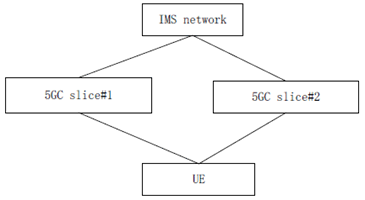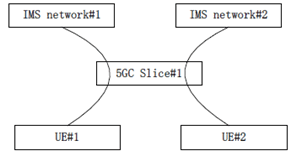Content for TR 23.700-10 Word version: 17.1.0
4 Architecture Assumptions
5 Key Issues
5.1 Key issue 1: Network Slicing and IMS
5.2 Key issue 2: Routing of IMS traffic via a localized UPF
5.3 Key issue 3: Placement of IMS application server in localized environments
5.4 Key issue #4: IMS utilizing services provided by 5GC NFs other than PCF and HSS
...
...
4 Architecture Assumptions p. 7
Void
5 Key Issues p. 7
5.1 Key issue 1: Network Slicing and IMS p. 7
In release 16, 5GC developed capabilities to divide the network into slices to better offer services to users and devices - in many cases the details of network slicing do not impact IMS, however if the IMS domain offers different services to different 5GC network slices or one 5GC network slice there may be some impacts. This key issue investigates the impacts to the IMS domain due to 5GC network slicing, and how a IMS network can ensure a user or device with multiple 5GC network slices and multiple services offered by IMS from utilizing the appropriate 5GC network slice for each service on IMS and prevent inappropriate services been used from the incorrect 5GC network slice.
Examples of the use cases that solutions to this key issue will enable include:
Use Case A: Different 5GC slices optimized for different services on IMS
In this use case each 5GC slice supports a different service offered by IMS and the 5GC slice is optimized for the media type associated with the service on IMS. It is possible that either a shared or separate IMS network provides the services for each slice (scenario 1 or scenario 2 described below).
Figure 5.1.1 shows an example implementation of this use case where 3 5GC slices are used, one for IMS service #1, one for IMS service #2, and one for IMS service #3. The diagram shows the association of the services on IMS to their appropriate slice. The services on IMS can be supported by a shared IMS network (i.e. Scenario 2), in which case the 5GC slices will connect to a common IMS network, but this is out of scope of the present document.
An IMS service in this context is identified by an ICSI as defined in TS 24.229.

Figure 5.1.1: Example use case with different 5GC slices optimized for different services on IMS
(⇒ copy of original 3GPP image)
(⇒ copy of original 3GPP image)
Use Case B: Different 3rd party 5GC slices with support for 3rd party services on IMS
In this use case separate 5GC slices are operated by different parties (some separate from the network operator); each 5GC slice is used to support services on IMS according to the 5GC slice operator's service needs; these services on IMS may be different or duplicated per slice according to service requirements. Additionally, some 5GC slices may provide non-IMS services. While it is possible that a shared IMS network provides the services for each slice (as per scenario 2 described below), this is an unlikely implementation and it is assumed each party has their own IMS network (as per scenario 1 described below).
Figure 5.1.2 shows an example implementation of this use case where 3 5GC slices are provided, one provided by an automobile manufacturer, one provided by an automotive entertainment service provider, and one provided by a network operator. A different mix of IMS and connectivity services are provided by each 5GC slice. The diagram shows the association of the services on IMS to their appropriate slice, however as each slice is provided by different parties it is unlikely that the services on IMS share an IMS network (as in Scenario 2), or different IMS services provided via one 5GC slice (as in Scenario 3); thus each 5GC slice would be associated with a different IMS network supporting the services on IMS associated with the 5GC slice.

Figure 5.1.2: Example use case with different 3rd party 5GC slices providing services on IMS
(⇒ copy of original 3GPP image)
(⇒ copy of original 3GPP image)
Three scenarios are possible (and may be mixed when more than 2 slices are considered):
Scenario 1 - Each 5GC network slice is associated with a separate and distinct IMS network

Figure 5.1-3: UE connects to two IMS networks through two 5GC network slices
(⇒ copy of original 3GPP image)
(⇒ copy of original 3GPP image)
This scenario includes the case where UE access different IMS networks via SNPNs.
Scenario 2 - Each 5GC slice is associated with a common IMS network

Figure 5.1-4: UE connects to common IMS network through two 5GC network slices
(⇒ copy of original 3GPP image)
(⇒ copy of original 3GPP image)
This scenario considers the case where signalling and media use different slices, for example all signalling use 5GC slice #1 and all media use 5GC slice#2 in Figure 5.1-4.
Scenario 3 - One common 5GC network slice is associated with multiple IMS networks.

Figure 5.1-5: Two UEs connect to separate IMS network through one common 5GC network slice
(⇒ copy of original 3GPP image)
(⇒ copy of original 3GPP image)
In this scenario, multiple IMS services are provided by IMS networks belonging to separate IMS domains. Different UEs accesses to IMS services via the same/shared 5GC slice to corresponding IMS networks using independent IMS registrations.
This scenario includes the case where UEs access different IMS networks via a SNPN.
Solutions may relate to one, two or all, of these scenarios.
The following is a list of what aspects the solutions to this key issue need to address:
- What information the UE needs to be able to select an appropriate slice.
- Any changes to the P-CSCF discovery procedures due to 5GC slicing.
- If any additional information is needed for the UE and IMS network to identify services supported by the IMS network.
- How the UE access to different IMS network independently via same 5GC slice.
5.2 Key issue 2: Routing of IMS traffic via a localized UPF p. 11
5.2.1 Description p. 11
The 5GC enables traffic to route via localized UPF close to the edge of the network (in some cases adjacent to the RAN nodes). Some services offered by the IMS network may be able to benefit from the lower latency and/or lower backhaul requirements that such deployments can enable, however current IMS applications and services are not able to leverage these capabilities. This key issue investigates the interactions required to leverage localized routing of IMS media and signalling traffic, the changes to enable effective control and management of such routing, and impacts of mobility and roaming.
5.2.2 Requirements p. 11
Example Use Case A:
Routing of IMS traffic (e.g. video) between two (or more) users using an efficient UP path.
Example Use Case B:
A "best effort video service" where the IMS video traffic from UE is offloaded at a UPF closer to the UE to minimize the backhaul resource usage based on a decision by the IMS.
The following is a partial list of the issues to be addressed:
- How can the IMS network influence or control how the 5GC selects the UP path.
- Which IMS node interacts with the 5GC (i.e. IMS AS, S-CSCF, or other IMS node).
- How does an AS request traffic to route using a local UPF.
- How does IMS request traffic to route using (or prevent routing using) a local UPF.
- How is the mobility of the UE considered, and how is service continuity ensured.
- If the UE is roaming, how can the localized routing be extended into the VPLMN (if supported).
- How does IMS request Data channel media to route using (or prevent using) a local UPF.
5.3 Key issue 3: Placement of IMS application server in localized environments p. 11
5.3.1 Description p. 11
The 5GC in release 15 defined some functionality to enable "mobile edge computing" (i.e. computing resources located close to the edge of the network) to enable enhanced services to users. The functionality defined in release 15 focused on general compute applications, and did not analyse the special case of IMS applications. This key issue investigates the enhancements to current capabilities of IMS and 5GC to enable the operation of IMS servers in the mobile edge space.
5.3.2 Requirements p. 11
Example Use Case A:
For a given venue (e.g. stadium) IMS videos may be stored and retrieved locally for playback only on UE's that are located on a group of small cells that serve the venue.
Example Use Case B:
Mission critical services that require optimization of signalling traffic as well as media may require, placement of P-CSCF and AGW (or other IMS FE) close to AN.
The following is a partial list of the issues to be addressed:
- How can IMS leverage 5G support for edge computing.
- What additions to IMS and 5G support for edge computing capabilities are required.
- What restrictions are there (if any) on IMS applications in the edge network.
- How are the localized IMS applications identified.
- How are IMS applications outside the local PLMN impacted (e.g. roaming).
- What impacts does the solution have on mobility.
- What impacts does the solution have on service, and application continuity.
- Is there any further impact on routing of IMS media (including Data channel media) and IMS signalling.
5.4 Key issue #4: IMS utilizing services provided by 5GC NFs other than PCF and HSS p. 12
5.4.1 Description p. 12
All of the 5GC control plane NFs are specified as service based and any NF can be consumer of the services provided by other NFs, if supported by the procedures. In 3GPP Rel-16, it has been already defined how the IMS can utilize services provided by the PCF and HSS via Npcf and Nhss_ims interfaces, respectively.
In IMS network, the P-CSCF needs to be notified of some events related to access network. This information can be used in IMS network e.g., for emergency services, billing, LI, service trigger, etc.
5.4.2 Requirements p. 12
An example of such an event related to the access network is the retrieval of the UE location information. For the purpose of UE location information retrieval in VoLTE case, the P-CSCF subscribes to notification of such events over Rx interface. Since 5GC supports SBI, IMS network can use directly the SBI provided by AMF to subscribe to notification of these events.
This key issue addresses the following aspects:
- Which services provided by which 5GC NFs other than PCF and HSS are needed to be utilized by IMS.
- Whether and how IMS can utilize services provided by 5GC NFs other than PCF and HSS.
- For UE location information retrieval, how IMS can determine the UE location entities with service operations (e.g. determination of the visited PLMN ID in case of Home-Routed VoLTE roaming).